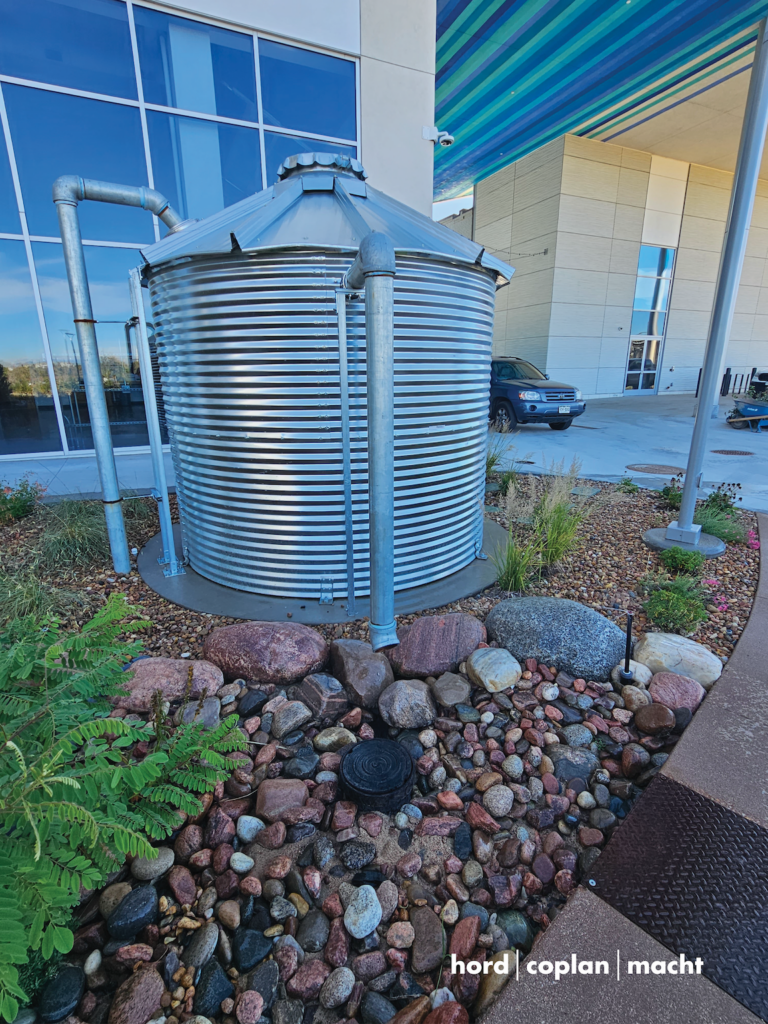Outdoor space as a living laboratory
The CSU Spur Backyard functions as a living laboratory where scientists study plant health, water quality, green infrastructure, urban agriculture, and more. The outdoor space features landscape architecture representing the state’s major watersheds and allows visitors to enjoy a break in the Colorado sunshine while connecting with educational opportunities and interactive, rotating programming.
Backyard landscaping and plant selection
The Backyard was designed to reflect the four major watersheds found in Colorado: South Platte, Arkansas, Rio Grande, and Colorado River. The Continental Divide is represented with an interactive water pump to help visitors understand how water moves through the watersheds, flowing either east or west, into engineered bioswales.

Native and low-water-needs or “xeric” plants are featured in the Backyard and are well adapted to this region’s semi-arid climate. The Backyard features native or adaptive and locally available plants that can thrive in Colorado’s different geological conditions.
Bioswales
Bioswales are landscape features that collect contaminated stormwater runoff, soak it into the ground, and filter out pollution. Bioswales are designed to capture runoff coming from large areas of impervious surfaces like streets and parking lots, and they have specific design features such as layers of engineered soil and gravel, perforated pipe underdrains, and overflow structures to help handle runoff from large storms.
Like a super-sized rain garden, the Backyard bioswales use native or adaptive plants that require less water but help the ground absorb more precipitation while also preventing erosion. Engineers and landscape architects worked together to design and build the CSU Spur bioswales.
From the Backyard, visitors can also look through the glass doors into the Water TAP lab, where water treatment technologies are advanced to promote widespread adoption of more sustainable water recycling and reuse practices. For example, monitoring and sensing technologies are evaluated in the TAP to assess the performance of the Backyard’s landscaped bioswales. The Backyard allows researchers to study the flow rate and filtration capabilities of these nature-based water treatment systems.
Rainwater collection & irrigation
A metal tank in the Backyard holds water that is collected from the Hydro building rooftop then piped and treated in the Water TAP lab before being pumped into a storage vessel. This water, aka roof runoff, is used to water sections of the Backyard plants where underground monitoring equipment collects data on water quality and flow.
The roof runoff is also used directly inside the Water TAP lab to evaluate different combinations of treatment and use such as membrane filtration and biological, microbial or ultraviolet treatment.
CSU works with Denver Water to return the same amount of water collected through this mechanism to the South Platte River to make sure the river ecosystem and aquatic life is not disturbed.


Experimental test plots
In a collaborative research project jointly funded by the Mile High Flood District and City and County of Denver, CSU researchers, Sybil Sharvelle and Jennifer Bousselot, are advancing innovations in stormwater management in Spur’s Backyard which functions as a unique “living laboratory.”
Experiments occur in two specially designed test plots that mimic streetside planters commonly used in urban landscapes along the Colorado Front Range.
These experimental plots are filled with soil mixtures (media) and vegetation (plants) typically installed in streetside planters across the Denver area. The plots include built-in systems to irrigate the plants using stormwater runoff collected in vaults underneath the Backyard and sampling equipment to gather data on water quality, flow rates, plant health, and other important performance-related information.
Agricultural plots
The Backyard is also home to several urban agriculture plots where CSU researchers show how urban spaces can be used for plant and food production. These plots serve as a research and demonstration site to investigate water use, food production, plant-pollinator interactions, seeding, and other emergent industry questions. Plumbing inside Hydro’s Water TAP lab can be connected to the irrigation system to explore how different water sources, such as graywater or stormwater collected in Hydro, can be used to water food crops in urban areas.
Hydro green roof
The Hydro rooftop houses an extensive photovoltaic system, an array of solar panels that use energy from the sun to generate electricity. Planters are located directly below the solar panels providing simultaneous power generation and plant or edible crop production. These are commonly referred to as “agrivoltaic” or “argisolar” systems. This system is not publicly accessible, but guests can stop by the green roof on Terra to visit a living rooftop garden or walk to the northwest corner of the Backyard to catch a glimpse of the solar arrays from the ground!
South Platte River Access
In addition to all that the Backyard has to offer, the space parallels the South Platte River, where restoration and new riverfront offerings, including walking paths and an amphitheater, are under development. It’s an easy walk down to the river from the Backyard to explore one of Colorado’s most important waterways.
Crescendo
The Backyard is also home to one of CSU Spur’s eight art installations, titled Crescendo, made up of large concrete waves, designed and installed by local artist Nikki Pike.

Hours
Monday-Friday: 9 a.m.-5 p.m.
2nd Saturday of every month: 10 a.m.-2 p.m. (closed all other Saturdays)
Closed Sundays
Location
4777 National Western Dr.,
Denver, CO 80216
© 2024 Colorado State University System.
All Rights Reserved.
Privacy Policy | Equal Opportunity Statement
JOCELYN HITTLE
Associate Vice Chancellor for CSU Spur & Special Projects, CSU System
Jocelyn Hittle is primarily focused on helping to create the CSU System’s new Spur campus at the National Western Center, and on supporting campus sustainability goals across CSU’s campuses. She sits on the Denver Mayor’s Sustainability Advisory Council, on the Advisory Committee for the Coors Western Art Show, and is a technical advisor for the AASHE STARS program.
Prior to joining CSU, Jocelyn was the Associate Director of PlaceMatters, a national urban planning think tank, and worked for the Orton Family Foundation. She has a degree in Ecology and Evolutionary Biology from Princeton, and a Masters in Environmental Management from the Yale School of Forestry and Environmental Studies.
Jocelyn grew up in Colorado and spends her free time in the mountains or exploring Denver.
TONY FRANK
Chancellor, CSU System
Dr. Tony Frank is the Chancellor of the CSU System. He previously served for 11 years as the 14th president of CSU in Fort Collins. Dr. Frank earned his undergraduate degree in biology from Wartburg College, followed by a Doctor of Veterinary Medicine degree from the University of Illinois, and a Ph.D. and residencies in pathology and toxicology at Purdue. Prior to his appointment as CSU’s president in 2008, he served as the University’s provost and executive vice president, vice president for research, chairman of the Pathology Department, and Associate Dean for Research in the College of Veterinary Medicine and Biomedical Sciences. He was appointed to a dual role as Chancellor in 2015 and became full-time System chancellor in July 2019.
Dr. Frank serves on a number of state and national boards, has authored and co-authored numerous scientific publications, and has been honored with state and national awards for his leadership in higher education.
Dr. Frank and his wife, Dr. Patti Helper, have three daughters.
We’ll see you Saturday!
2nd Saturday at CSU Spur is 10 a.m.-2 p.m. this Saturday (May 11)! Join us to learn about the South Platte River’s plants and animals, check out the Denver Museum of Nature & Science Curiosity Cruiser and Little Shop of Physics experiment stations, taste test chicken nuggets in the Sensory Lab, and meet Wiz Kid!
Hope to see you there!
